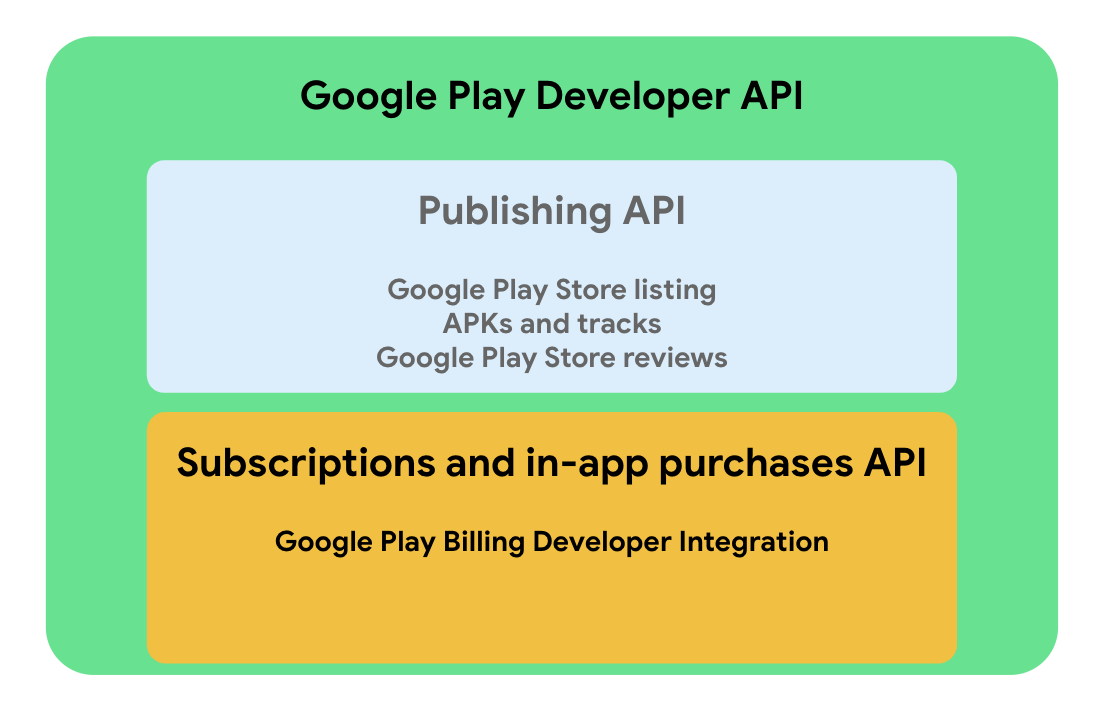Google Play の課金システムは、Android アプリでデジタル商品とデジタル コンテンツを販売するためのサービスです。1 回だけの購入で収益を上げることも、サービスを定期購入できるようにすることも可能です。Google Play では、Android アプリとサーバー バックエンドの両方と統合するための API 一式を用意しており、ユーザーは安全性が高く使い慣れた Google Play で購入できます。
統合アーキテクチャ
このセクションでは、構築できるさまざまな機能モジュールと、プロセスの合理化に使用できる API とライブラリを紹介します。

Play Billing Library を使用して、Google Play の課金システムと Android アプリを統合できます。このライブラリにより、アプリ内の各ユーザーが利用できるローカライズされた商品を提供する Google Play 開発者サービスレイヤと、購入フローの開始やその結果の処理といった、その他の必要なユーザー操作を処理するメソッドとの通信が可能になります。
Google Play の課金システムをサーバー バックエンドと統合して、必要なデベロッパー フローも作成する必要があります。購入管理とクロス プラットフォームでの利用資格の効率性と安全性を確保するうえで、これは重要です。この統合は Google Play Developer API の Subscriptions and In-App Purchases API を使って作成できます。バックエンドの統合では、一部の Google Cloud Platform ツールも使用します。

用語
このセクションでは、Google Play の課金システムをアプリに統合する際に目にする可能性がある、テクノロジーと概念について大まかに説明します。このリストを参照しながら、統合ガイダンスに沿って進めてください。
テクノロジー
- Google Play: ユーザーがアプリやその他のデジタル アイテムをダウンロードできるオンライン ストアです。
- Google Play Console: アプリを Google Play に公開するためのインターフェースを備えたプラットフォームです。Google Play Console には、Google Play で販売する商品やコンテンツなど、アプリの詳細も表示されます。
- Google Cloud Console: Google Play Developer API などのバックエンド API を管理するプラットフォームです。
- Google Play Billing Library: Google Play の課金システムをアプリに統合するために使用できる API です。
- Google Play Developer API: 公開とアプリの管理タスクをプログラムで処理する際に使用できる REST API です。
- Cloud Pub/Sub: 独立したアプリ間のメッセージの送受信を可能にする、フルマネージドのリアルタイム メッセージ サービスです。Google Play は Cloud Pub/Sub を使用して、リアルタイム デベロッパー通知を送信します。Cloud Pub/Sub を使用するには、Cloud Pub/Sub API が有効な Google Cloud Platform(GCP)上にプロジェクトが存在する必要があります。GCP と Cloud Pub/Sub の使用経験がない場合は、クイックスタート ガイドをご覧ください。
- リアルタイム デベロッパー通知Cloud Pub/Sub を利用して、Google Play が管理する定期購入のステータスの変更をリアルタイムでモニタリングできるメカニズムです。
- 安全なバックエンド サーバー: Google Play の課金システムをアプリに統合する際に、安全なバックエンド サーバーを使用して請求関連のタスク(購入確認、定期購入固有の機能、リアルタイム デベロッパー通知の処理など)を実装することを強くおすすめします。
- Google Play ストア アプリ: Google Play に関連するすべてのオペレーションを管理するアプリです。アプリによるリクエストはすべて、Google Play ストア アプリが処理します。
概念
- フロー: フローは請求関連のタスクに含まれる一般的なステップを示します。たとえば、購入フローはユーザーがアイテムを購入するときに実行するステップの概要を示します。定期購入フローは、定期購入のステータス間の遷移を示します。
- 利用資格: ユーザーがアプリ内アイテムを購入すると、アプリ内でそのアイテムの利用資格が与えられます。1 回限りのアイテムの場合、そのユーザーはアイテムを永続的に利用できるようになります。定期購入の場合、定期購入が有効になっている間は利用権があります。
- プロダクト ID: 特定のアイテムタイプの ID です。
- 購入トークン: Google Play 上のアイテムに対する購入者の利用資格を示す文字列です。特定のアイテムに対して Google ユーザーが支払いを行ったことを示します。
- オーダー ID: Google Play 上の支払いトランザクションを示す文字列です。オーダー ID は支払いトランザクションが発生するたびに作成されます。この文字列は、購入者にメールで送信される領収書に記載されます。オーダー ID を使って、Google Play Console の [注文管理] で払い戻しを管理できます。オーダー ID は、販売と支払いのレポートでも使用されます。
次のステップ
Google Play の課金システムをアプリおよびサーバー バックエンドと統合するには、設定ガイドをご覧ください。

